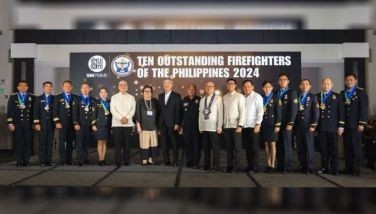Lifestyle report from Seattle: Philippine Airlines gets its seventh 777


When Boeing delivered a brand-new 777-300ER to Philippine Airlines (PAL), it was a surprisingly emotional moment.
You don’t realize it, but a plane is an artisan work of art: thousands of hands and man hours are required to build it, and when it’s finally presented to the airline that ordered it, the artisans who helped make it are on hand to see their baby off.
In Philippine Airlines’ case, three of those artisans had chicken adobo and bibingka with us during our final lunch at the Boeing Delivery Center in Everett, Washington, a couple of hours before Capt. James Conner took the controls of the brand-new triple 7 and flew PAL president and chief operating officer Jaime Bautista and a Philippine delegation composed of the PAL team, government and aviation officials, and the media, from Paine Field in cool and cloudy Washington (about 25 miles north of Seattle), almost 14 hours to hot and sunny Manila.
Seventh 777
So how, exactly, is a plane delivered?
Unlike a normal pregnancy, this delivery took two years instead of nine months, from the time of sale to the actual delivery on Oct. 28, 2016.
PAL already has six Boeing 777-300ERs in its fleet. “This is our seventh triple 7,” said Bautista, who finds that combination of numbers extremely auspicious. “It’s all sevens,” he chuckles. “That’s lucky in feng shui.”
More specifically, he declared that PAL will use these wide-body, long-haul 300 ERs (the ER stands for “Extended Range”) to serve more passengers in the United States and Canada. “This aircraft we will use to increase frequency in Los Angeles and San Francisco, and we’re taking delivery of our eighth 777-300ER in December,” Bautista said. “This will be supported again by our friends from Intrepid Aviation (from whom PAL leases the planes), and with the delivery of these airplanes we will be operating twice daily to Los Angeles starting December, in time for the Christmas peak season. I’m sure our passengers will love this airplane because it has been proven to be the best aircraft for our trans-Pacific operations.”
Space For Over 1,200 Balikbayan Boxes
At Boeing’s Customer Experience Center in Seattle, regional director for product marketing Jeffrey Haber explained what makes the 777-300ER so special. Powered by two GE90-115B engines that are so large “you can fit most of the 737 fuselage within them,” the 300ER has the capacity to carry 396 passengers in two classes, and a state-of-the-art flight deck in common with Boeing’s 787 Dreamliner. Improvements in aerodynamics and engine and cabin weight reduce fuel use by two percent, while the ER can fly 150 nautical miles more, carry a payload of 3.9 tons (which means space for over 1,200 balikbayan boxes), and 38 more passengers than its rival aircraft.
Built of composite materials that don’t corrode and “last forever,” the 777 is the first plane designed digitally, and it’s 99.5 percent reliable ETA-wise: “This airplane is on time, nearly all the time,” Haber said.
Consequently, the triple 7 has received more travel industry awards than any other aircraft, and is outselling its closest competitor, the Airbus A350, by more than four to one: 1,891 aircraft have been ordered by 68 customers worldwide — no small feat considering its price is listed at around US$330 million.
Boeing’s Aircraft Of The Future
Haber also let us glimpse Boeing’s next-generation aircraft: the 777X. Seven feet (2.1 meters) longer and four inches wider than the 300ER, it can accommodate 18 more passengers and boasts longer and lighter composite wings for 12 percent better fuel efficiency. (The longer wingtips can fold up so the 777X can fit into current airport gates.)
With GE9X engines that are five percent more efficient than any other engine, its 787-inspired flight deck will be the first to feature touch screens in commercial aviation. “Pilots can fly it with five days of training,” Haber claims. “It will offer a new level of passenger experience with projection screens, open ceilings, larger windows, and higher walls in First and Business Class for greater privacy.” Not to mention aisle access for every passenger. The first delivery of the 777X is slated for 2020.
Regarding the possibility of PAL ordering such high-tech planes, “I’m trying to work on future orders,” said Boeing’s sales director Chris Hartshorn.
A 60-Year Partnership
The night before the plane was delivered, at a celebratory dinner in Seattle’s Museum of Flight, Boeing’s senior vice president for global sales and marketing John Wojick said they picked that location because the Red Barn was where the Boeing Company started over 100 years ago, and where they built their first airplane.
“What’s really remarkable is we’ve been partners with Philippine Airlines for over 60 years, and they’ve been in existence for 75,” said Wojick, “so 60 of those 75 years they’ve been a partner of the Boeing Company when they first started flying planes across the Pacific in 1946 with the Douglas DC-4. They were one of the first Asian carriers to actually fly to the United States, which is an amazing record to be very, very proud of.”
‘The Heart Of The Filipino’
While PAL celebrates 75 years with a new slogan, “The Heart of the Filipino,” and is expanding and modernizing its fleet, Transportation Undersecretary Bobby Lim says the government is doing what it can to improve the current traffic situation at NAIA. “It’s a 40-minute delay departing from the airport, and a two-hour delay when arriving,” he notes. “It’s a crisis in a sense because our airports cannot accommodate any more flights.”
To allay the situation, the Department of Transportation is implementing “procedure, policy and investment.” Policies include not having general aviation (private and chartered planes) in between 12 p.m and 7 p.m., the peak hours of commercial aviation at the airport. “Also, the Five-Minute Rule: a pilot has to declare truthfully if he’ll be ready to take off within five minutes. If he’s not ready within that time, he’s moved to the back of the queue.”
They’re also “lightweighting” airports by having airlines schedule flights after sunset at night-rated provincial airports like Tagbilaran, Caticlan, and Cebu to ease traffic during peak hours.
“Tourism is necessary for economic development,” Lim says. “Travel is a global industry now, and we need more connectivity, and to invest more in technology.”
PAL, meanwhile, is finding its own solutions by flying from airports other than NAIA. “For example, we started flying Cebu to Los Angeles, and we can use the new airplane for that,” Bautista says. “Clark will be another. It’s a matter of time, because there are no more slots in Manila. Even in the evening, all the slots are full. We need an airport. For the meantime, ‘larger airplanes, less flights.’ Since September we’ve reduced flights to 100 flights a week. So instead of smaller airplanes we fly the bigger airplanes, with more flights out of Cebu, then cheaper flights out of Clark by next year.”
A New Passenger Experience
After the ribbon was cut and Father Alex Pablo blessed the plane, we were one of the lucky 40 who had the plane all to ourselves as it winged its way from Boeing’s Delivery Center home to the Philippines.
I love that the new Business Class seats are 100-percent lie-flat, with more privacy if you need it courtesy of a sliding divider above the armrests. A little foot bench in front of you opens up to stow a small bag, and becomes part of the flat bed when the seat is reclined. It was so comfortable and private that I had a really deep sleep.
Economy Class is wider, with more space for seats. Those iPads of yore are no longer with the 777’s state-of-the-art entertainment system, which all classes share. While Business Class has bigger screens, Economy now has personal video screens that are bigger than iPads, with the same wide selection of movies, TV shows and games. Seat recline seems improved as well, with easy-to-fold dining tables.
When I heard from PAL’s head of external corporate communications Cielo Villaluna that this 777-300ER we rode home on had started plying its North American route, flying last Thursday from Manila to Vancouver, I felt emotional again. For a few brief hours we’d had this plane all to ourselves, but now Boeing’s baby is doing what it does best: serving all of PAL’s passengers.
* * *
For bookings and information, visit www.philippineairlines.com.



















